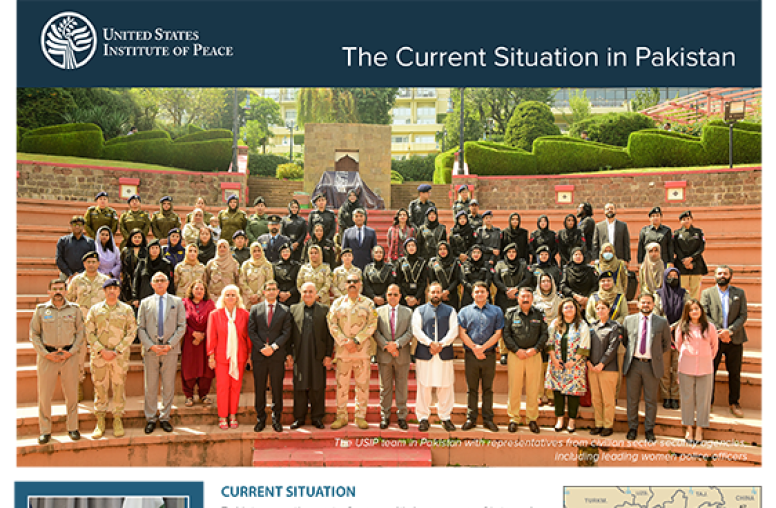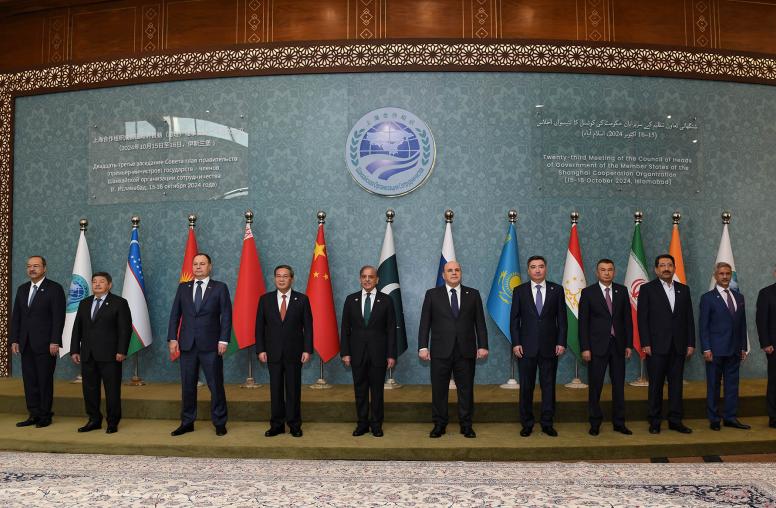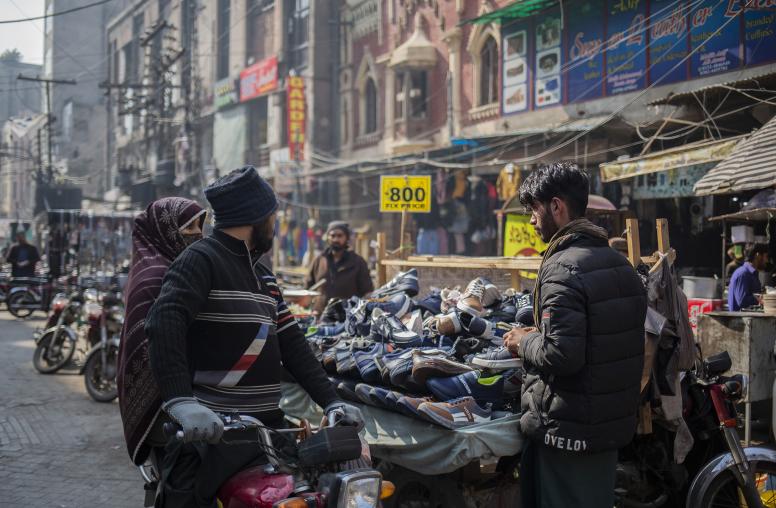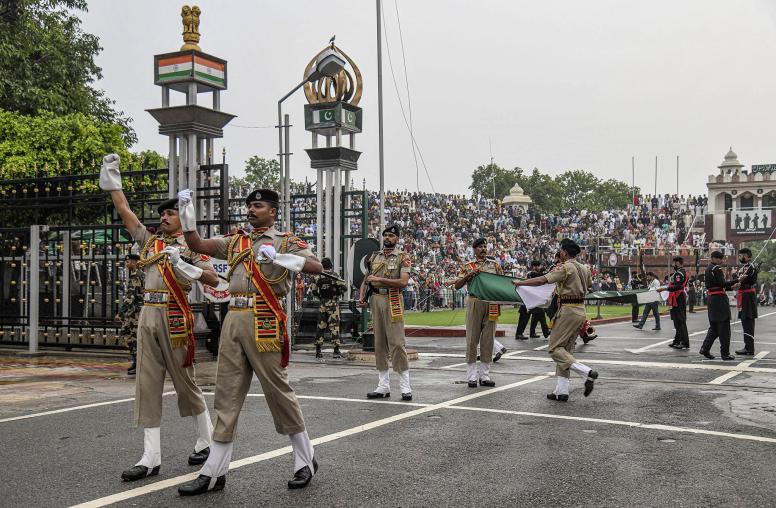In Pakistan’s Crisis, Judicial, Military Roles Will Be Vital
Upheaval over Imran Khan’s arrest roils a state already facing economic, political crises.
Pakistan’s eruption into new political crisis this week elevates the risks — in South Asia and beyond — of instability in a nuclear-armed state that is also the world’s fifth most populous. The authorities’ arrest of former Prime Minister Imran Khan triggered a confrontation between his many supporters and Pakistan’s politically powerful military, which many Pakistanis say precipitated Khan’s detention. As U.S. policymakers monitor this still-unfolding crisis, a first useful step may be to carefully press Pakistani leaders to avoid any unlawful repression or military intervention.

On May 9, paramilitary troops in riot gear broke through doors and windows of a courthouse in Islamabad to arrest Khan on charges issued by Pakistan’s anti-corruption body. The case alleges that Khan and his wife received land worth millions of dollars for a university as a bribe from a real estate tycoon.
The arrest caused immediate political upheaval in Pakistan, where Khan is extremely popular. Khan’s party and supporters instantly assumed that the military, which has long wielded decisive influence in Pakistani politics, ordered Khan’s arrest. Protests broke out across the country, including outside military installations. In a notable incident, supporters of Khan gathered outside the Pakistani army's headquarters in Rawalpindi, broke into the main entrance, and damaged the military’s emblem. Protesters in Lahore, Khan’s hometown, broke into the home of a senior military commander, ransacking it and setting it on fire. Other incidents of violence across the country caused casualties. In response, the military was called in to aid police in Islamabad, and in Punjab and Khyber Pakhtunkhwa provinces.
Late on Thursday, the Pakistani Supreme Court ordered Khan’s immediate release to a court-controlled guesthouse, declaring the arrest illegal for having taken place on the premises of a courthouse.
The lead-up to Khan’s arrest
The current crisis, in particular the reaction to Khan’s arrest, is a result of Pakistan’s complicated civil-military relations, which have included coups and military influence over Pakistani politics. Khan’s arrest came after months of a major political tussle between Khan and his party — the Pakistan Tehreek-e-Insaf or PTI — on one side and the coalition government, led by Prime Minister Shehbaz Sharif, and the military establishment on the other. Since his removal from office in a parliamentary no-confidence vote in April 2022, Khan has campaigned against the military and coalition government, accusing both of colluding with the United States government to engineer his ouster. His supporters have responded with sustained large-scale protests over the past year — and in one protest rally, Khan survived an assassination attempt in which he was shot in the leg. Khan has also been seeking a swift general election in the country, anticipating a landslide victory.
The Sharif-led coalition government has been defiant in the face of Khan’s pressure tactics. The military has disputed Khan’s allegations and stated that Khan wants the military to step outside its constitutional role to help him. Khan alleges that the army has supported various political moves through the courts to contain him; there are dozens of registered cases against Khan now. Khan has criticized the military establishment — including the army chief, General Asim Munir — in rallies, interviews and on social media. Before his arrest, in what was his most significant escalation against the military, Khan accused a senior officer of Pakistan’s powerful Inter-Services Intelligence agency of plotting to assassinate him. These public and direct accusations are novel developments in a country where the military establishment has long been viewed as the guarantor of stability.
What is the current state of play?
Khan's arrest left his supporters angry and determined to continue protesting. His dramatic release by the court generated euphoria and reduced public rage, yet has left uncertainty about what may happen to Khan next. At the same time, Khan’s party faces a leadership vacuum, partly because it has no clear second-in-command to lead and most of the senior leaders have been arrested on charges of instigating and directing the violence against the military. Spontaneous grassroots mobilization in support of Khan is possible, but it remains to be seen whether the PTI can harness the tide of emotion to sustain a countrywide mobilization given the detention of much of its leadership and the prospect of Khan getting arrested again.
Meanwhile, the government and the military are trying to contain and deter further unrest by deploying the army across the country and authorizing the use of force if necessary. In a strongly worded press release, the military criticized Khan and characterized the attacks by PTI’s actions as unpatriotic: an assault on Pakistani institutions, notably army properties, that the country’s external enemies “could not accomplish for 75 years” of Pakistan’s existence.
Against this backdrop of political upheaval, Pakistan is in a severe economic crisis due to dwindling foreign exchange reserves and a high external debt burden, putting the country on the brink of default. Moreover, there is a heightened risk of terrorist violence. The Pakistani Taliban movement has increased its insurgency within Pakistan from what is now its safe haven in Taliban-controlled Afghanistan.
What happens next?
Four developments will significantly shape politics in Pakistan and determine the prospects of stability in the near term.
- Judicial intervention. The Supreme Court’s order to release Khan adds to tensions between the army and the court. The army had signaled its intent to hold the PTI leadership, including Khan, to account for the violence against military installations, so the release order, by offering reprieve to Khan and the PTI, dilutes the army’s plan. The court’s intervention may also shield Khan in future legal proceedings as judges are sensitive to cues from the Supreme Court’s chief justice. That could frustrate military leaders and push them to consider emergency measures, perhaps even direct intervention.
- Military cohesion. Khan’s future prospects and the government and the military’s ability to counter the PTI also depend, in great measure, on the military establishment’s cohesion. Pakistan’s military establishment, generally composed of senior officers in the army and intelligence services, has shown no overt signs of fracture, but the past year has included signs of its cohesion being under pressure. Khan and his party have significant support in military elite networks; retired military officers have been extremely critical of the establishment’s approach and its decision to distance itself from Khan since last year. Amid the widespread protests and judicial intervention, senior military leadership may be under pressure to de-escalate current tensions and take an off-ramp from the crackdown against the PTI. On the other hand, the sense of embarrassment and breach of honor due to PTI supporters’ attacks against military installations could create a “rally around the flag” effect, and Khan’s support within the military’s elite networks may begin to diminish. The military’s cohesion remains important to watch.
- Level of violence. An important factor will be the scale of violence. The government, in coordination with the military, has launched a major crackdown against the PTI for inciting and directing violence. While Khan’s release immediately eased popular anger, a re-arrest, which is possible, could revive protests. If protesters target military personnel and installations again, the crackdown could become more severe. Terrorist violence by the Pakistani Taliban, which has been surging, also could add to the instability. In general, more agitation and violence can trigger emergency measures, including countrywide curfews. That will also push the country towards a direct military intervention. But if the protests persist beyond those emergency measures, Khan may prevail, and the government and military could back off.
- Economic crisis. A wild card is Pakistan’s precarious economic situation. Pakistan has been muddling through a balance of payments crisis, and in the next few months, it has major repayments due to its multilateral, private and bilateral lenders. To manage these repayments and avert a default, Pakistan foremost needs rollover and refinanced loans of a couple of billion dollars from China. Pakistan is also looking to revive a program of loans from the International Monetary Fund (IMF), which remains stalled due to Pakistan not meeting the IMF’s conditions. The crisis will make it harder for Pakistan to convince the IMF — and possibly even Chinese leadership, which publicly called for political stability in the country — to provide the help necessary to avert default and keep the economy afloat. The narrow path for Pakistan to avert economic collapse has narrowed further.
What does this mean for the United States?
Pakistan is not high on the list of U.S. foreign policy priorities amid the U.S. focus on the Indo-Pacific region. Nonetheless, its stability remains a major interest, given the country’s possession of nuclear weapons and U.S. counterterrorism interests in the region — all of which depend on the military’s cohesion. The escalated political crisis has put these interests under stress. The prospect of a crackdown raises concerns about potential unlawful measures that could undermine the rights of Pakistanis and push the country closer to a direct military intervention such as an armed coup. At the same time, the United States has limited tools and leverage to mitigate the upheaval. For now, it may be useful for the U.S. government to carefully communicate to the Pakistani leadership the importance of attending to the military’s cohesion; avoiding unlawful steps, including excessive force against protesters; and not steering the country toward a direct military intervention.



